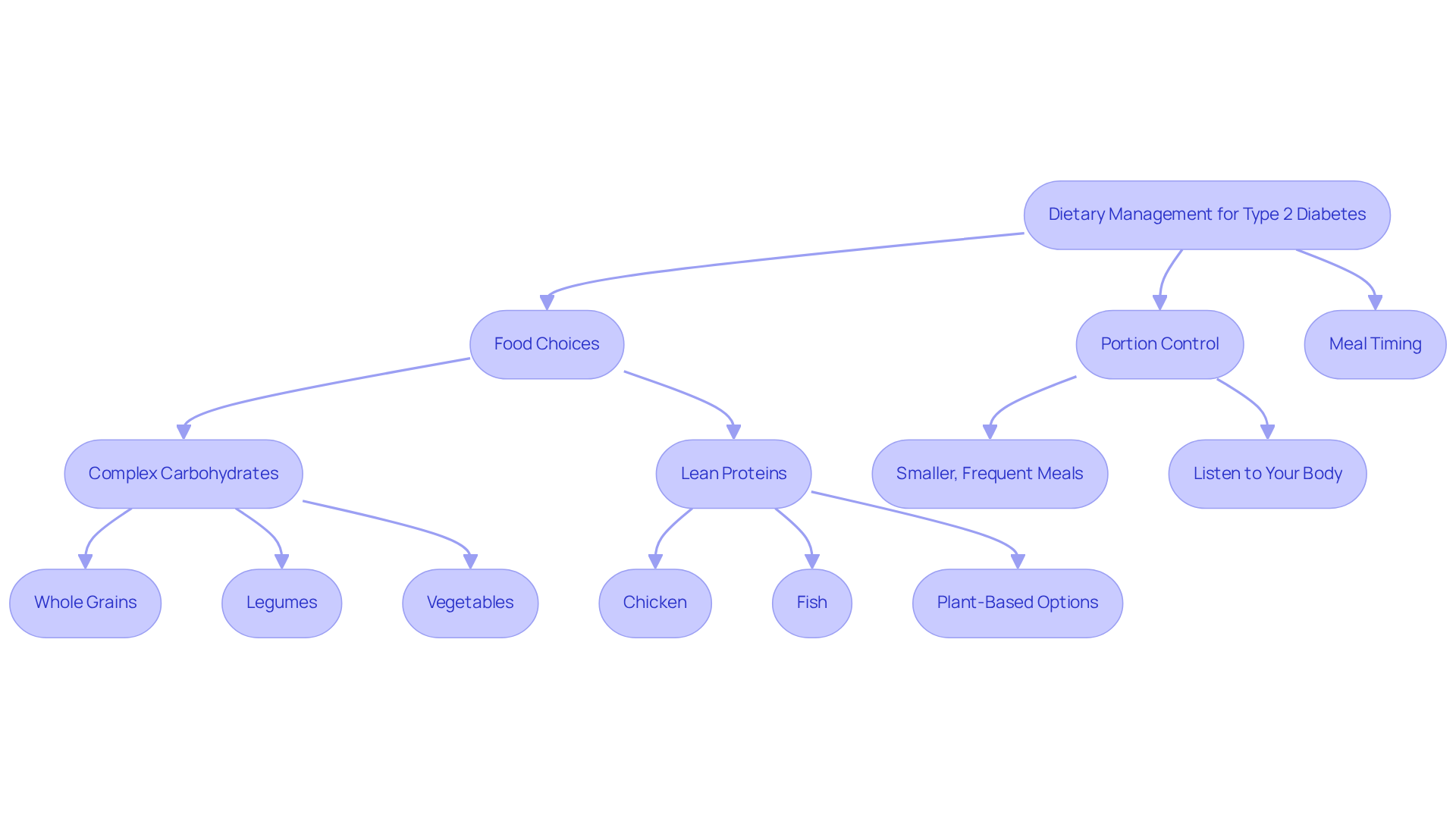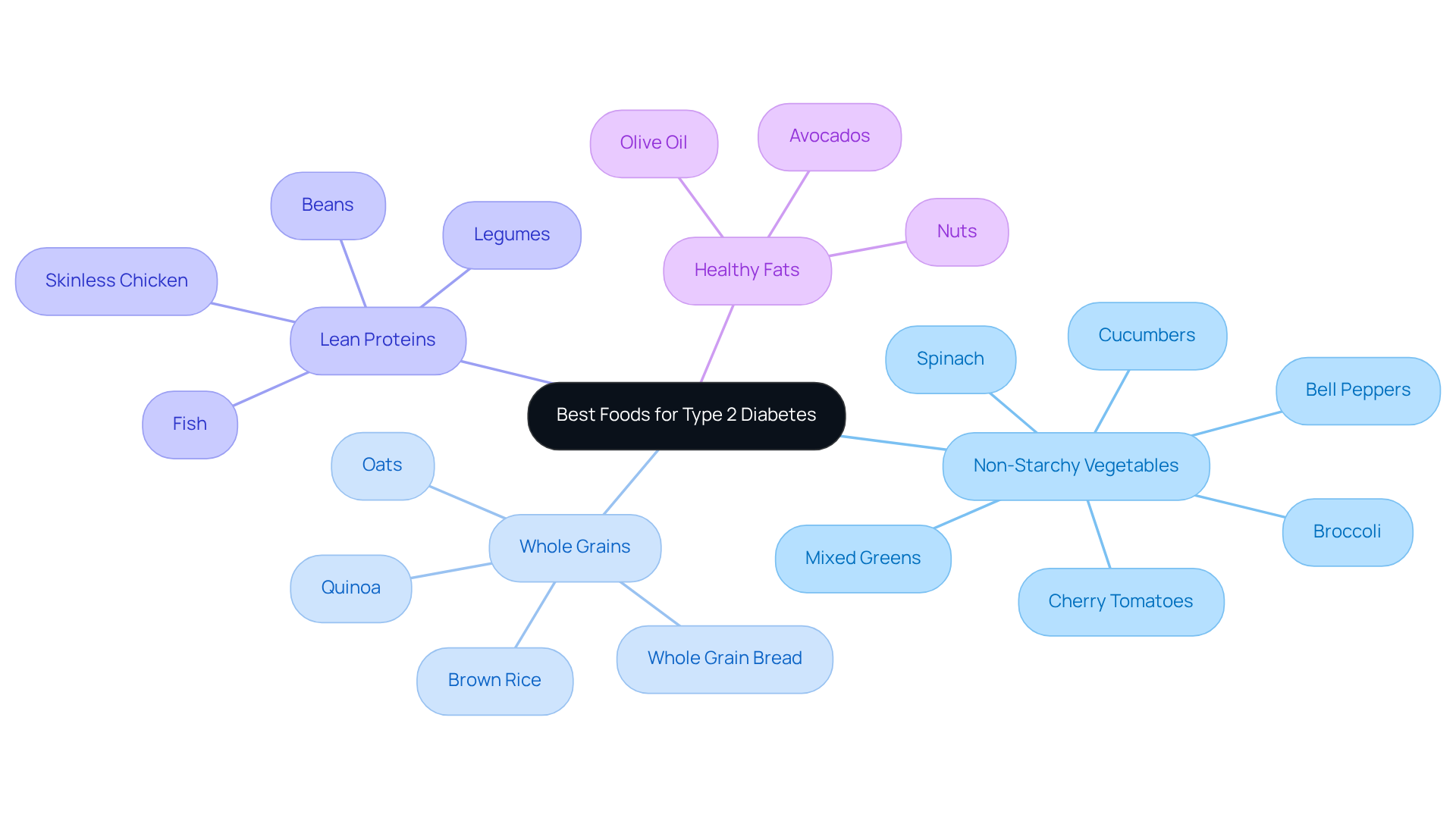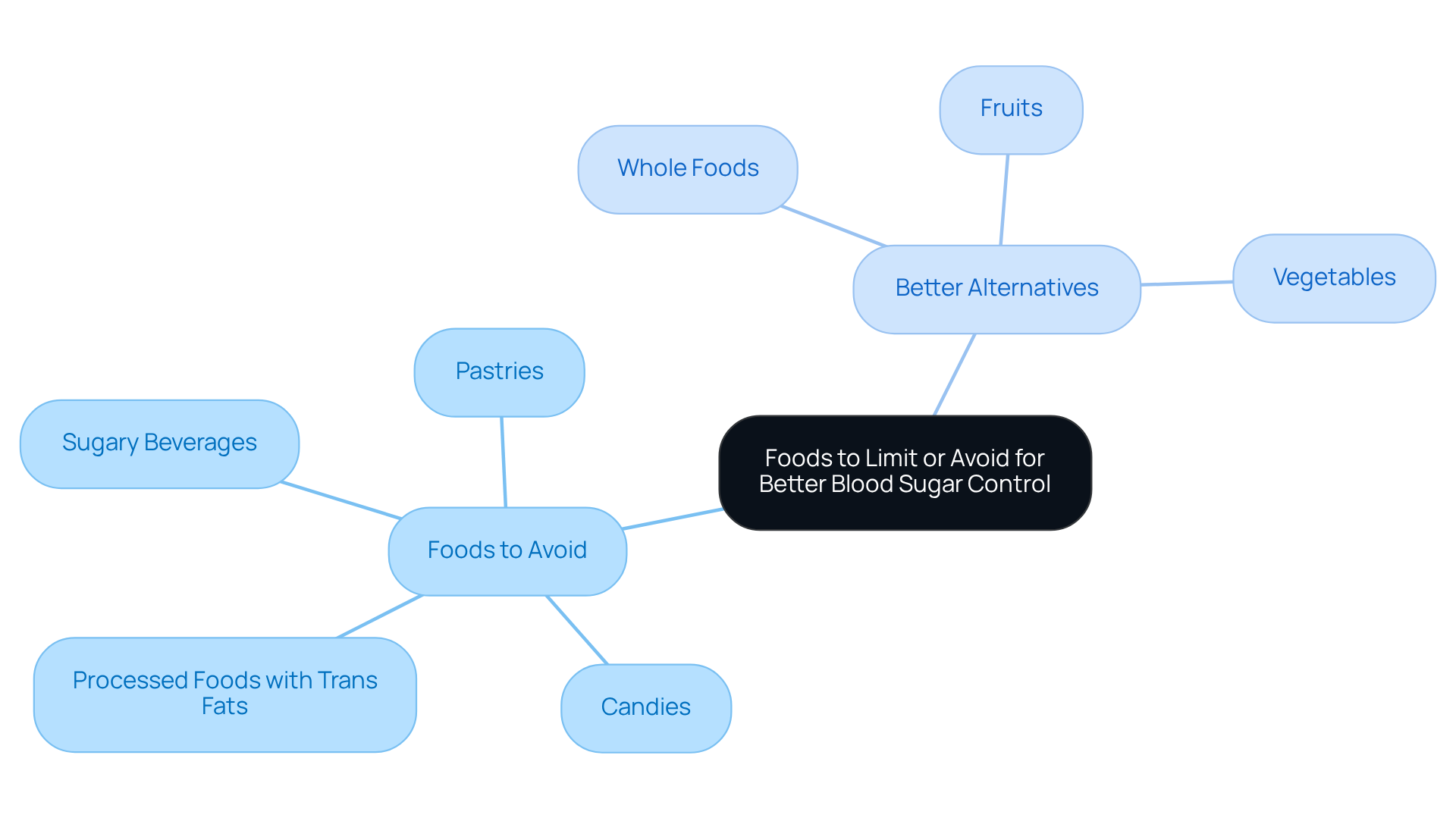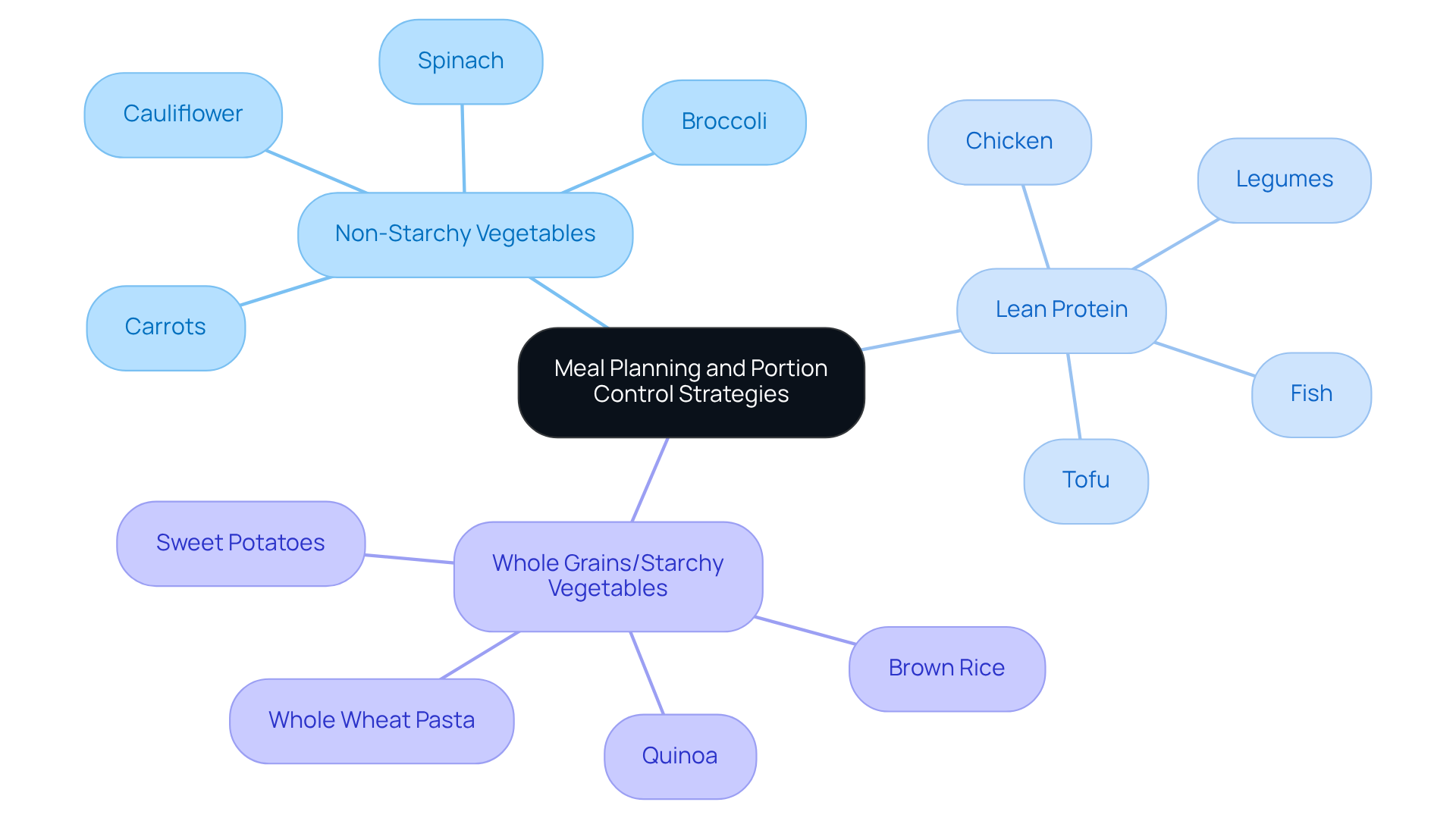Overview
Managing Type 2 diabetes can feel overwhelming, but understanding the right foods can make a significant difference in your journey. The best foods for this purpose include:
- Complex carbohydrates that are high in fiber
- Lean proteins
- Healthy fats
Think of:
- Whole grains
- Legumes
- Non-starchy vegetables
- Nourishing sources like avocados and nuts
These food choices not only help regulate glucose levels but also promote your overall health.
It's understandable to feel uncertain about meal planning, but incorporating these nutrient-dense options into your diet can be empowering. Consider balanced meals that feature these ingredients. For example, a hearty quinoa salad with black beans and colorful vegetables can be both satisfying and beneficial.
Remember, you're not alone in this journey. We are here to support you every step of the way. By making informed food choices, you can take control of your health and well-being.
Introduction
Understanding the intricacies of managing Type 2 Diabetes can feel overwhelming. It’s completely normal to have concerns, especially when it comes to making informed dietary choices. The right foods not only play a pivotal role in stabilizing blood sugar levels but also contribute to your overall health and well-being. With so many options available, you might wonder: how can you discern which foods are truly beneficial for you?
This article is here to help. We will explore the best foods for Type 2 Diabetes management, revealing essential dietary strategies that can empower you. Along the way, we’ll highlight common pitfalls that could hinder your progress, ensuring you have the support you need. Remember, you’re not alone in this journey, and we are here to support you every step of the way.
Understanding Dietary Needs for Type 2 Diabetes
Dietary control for individuals with Type 2 Diabetes is essential for preserving stable glucose levels and overall well-being. It's understandable to feel overwhelmed by dietary choices, but knowing what foods are best for type 2 diabetes, particularly those that are complex carbohydrates high in fiber, can make a significant difference. Foods such as whole grains, legumes, and various vegetables are examples of what foods are best for type 2 diabetes, as they help regulate glucose levels and enhance overall nutritional balance. For instance, a nourishing dish including quinoa, black beans, and steamed broccoli can provide prolonged energy while helping to reduce glucose spikes.
In addition to carbohydrates, it's important to consider what foods are best for type 2 diabetes, including lean proteins like chicken, fish, and plant-based alternatives, as well as healthy fats from sources like avocados and nuts, to further stabilize glucose levels and promote feelings of fullness. Nutritionists emphasize that understanding what foods are best for type 2 diabetes includes having a balanced plate that features a mix of these macronutrients, which is key to effective diabetes management. Remember, you’re not alone in this journey; support is available to help you navigate these changes.
Regular food timing and portion control are also essential. Consuming smaller, more frequent meals can assist in keeping stable glucose levels throughout the day. For example, a mid-morning snack of Greek yogurt with berries can prevent drops in energy and maintain stable glucose levels. It’s important to listen to your body and find what works best for you.
As we move into 2025, understanding what foods are best for type 2 diabetes, especially regarding the impact of carbohydrates on blood sugar, remains critical. Experts continue to advocate for mindful carbohydrate choices, particularly in discussing what foods are best for type 2 diabetes, highlighting that not all carbs are created equal. By prioritizing whole, unprocessed foods, you can learn what foods are best for type 2 diabetes to better manage your condition and improve your overall health outcomes. We are here to support you every step of the way, encouraging you to reach out for guidance and resources as needed.

Best Foods to Include in a Type 2 Diabetes Diet
A well-rounded Type 2 Diabetes diet focuses on what foods are best for type 2 diabetes, such as non-starchy vegetables, whole grains, lean proteins, and healthy fats. It's important to include non-starchy vegetables like spinach, broccoli, and bell peppers in your meals. These vegetables are low in calories and high in nutrients, making them a fantastic choice for your health. Imagine enjoying a colorful salad filled with mixed greens, cherry tomatoes, and cucumbers. Not only does it serve as a refreshing side dish or main course, but it also provides essential vitamins and minerals while helping you keep your calorie intake in check.
When considering what foods are best for type 2 diabetes, whole grains such as quinoa, brown rice, and oats are wonderful options because they are rich in fiber, which is crucial for regulating blood sugar levels. Picture starting your day with a hearty bowl of oatmeal topped with fresh berries. This nutritious breakfast not only fuels your morning but also helps maintain stable glucose levels throughout the day. Nutritionists often recommend incorporating these grains into your meals to improve satiety and support digestive health.
Lean proteins, including skinless chicken, fish, beans, and legumes, play a vital role in muscle maintenance and can help you feel full longer. For example, a grilled chicken breast served with a side of roasted vegetables creates a satisfying and balanced meal. Additionally, healthy fats from sources like avocados, nuts, and olive oil are essential for heart health, which is particularly important for those managing diabetes. Think of a simple avocado toast topped with sliced tomatoes as a delicious and nutritious snack.
Incorporating what foods are best for type 2 diabetes into your everyday meals can help you work towards improved glucose regulation and enhance your overall well-being. You're not alone in this journey; we are here to support you every step of the way. Embrace these choices as a path to a more balanced lifestyle.

Foods to Limit or Avoid for Better Blood Sugar Control
If you're managing Type 2 Diabetes, it’s important to know what foods are best for type 2 diabetes. Foods high in added sweeteners, refined carbohydrates, and unhealthy fats can lead to rapid spikes in blood glucose levels. For instance, sugary beverages, candies, pastries, and white bread can be particularly troublesome. Research indicates that consuming large amounts of added sweeteners may increase the risk of Type 2 Diabetes, highlighting the need for thoughtful dietary choices.
It’s also crucial to avoid processed foods that contain trans fats, such as fried products and certain baked goods, as they can negatively impact heart health. Instead, focusing on what foods are best for type 2 diabetes, like whole, unrefined foods, can help keep your glucose levels stable and improve your overall well-being. Remember, you’re not alone in this journey. Many dietitians emphasize the importance of reading nutritional labels to identify hidden sweeteners and processed carbohydrates, which can often be disguised under various names.
The American Diabetes Association recommends that you always check the nutrition facts label of any product you consider. Additionally, practicing mindful portion control is vital; even healthy foods can cause blood glucose spikes if eaten in excess. By making informed choices about what foods are best for type 2 diabetes and prioritizing nutrient-dense options, you can manage your diabetes better and enhance your quality of life.
It’s comforting to know that natural sugars found in fruits and vegetables are not linked to diabetes risk, setting them apart from harmful added sugars. We are here to support you every step of the way as you navigate your dietary choices.

Meal Planning and Portion Control Strategies
While managing Type 2 Diabetes can feel overwhelming, understanding what foods are best for type 2 diabetes and practicing effective food planning and portion control can make a significant difference. One helpful strategy is the 'plate method,' which divides a standard nine-inch plate into three sections:
- Half for non-starchy vegetables
- One-quarter for lean protein
- One-quarter for whole grains or starchy vegetables
This visual guide simplifies creating balanced meals without the stress of complicated calculations.
Imagine filling half your plate with colorful vegetables like broccoli, carrots, and spinach. Not only does this enhance your nutrient intake, but it also helps you feel satisfied while keeping calories in check. Lean proteins, such as chicken or legumes, should take up one-quarter of the plate, while the remaining quarter can be filled with wholesome carbohydrates like brown rice or quinoa. Many have found that this technique improves their dietary adherence and variety, leading to better nutritional outcomes.
Planning your meals in advance can help reduce those spontaneous eating moments, which is crucial for maintaining stable glucose levels. Keeping nutritious snacks, such as a handful of nuts or a cup of yogurt, within reach can also support portion control and prevent overeating during main meals. It's important to consistently track your blood sugar levels, as this provides valuable insights into how different foods and portion sizes affect your body. This awareness allows you to make necessary adjustments to your meal plans.
By incorporating these strategies, you're not only taking steps toward effective diabetes management but also discovering what foods are best for type 2 diabetes to nurture a healthier relationship with food. Remember, you're not alone in this journey; we are here to support you every step of the way, ultimately enhancing your overall well-being.

Conclusion
Understanding the best foods for managing Type 2 Diabetes is crucial for maintaining stable blood sugar levels and overall health. By focusing on nutrient-dense options like whole grains, lean proteins, and healthy fats, you can significantly improve your dietary choices and support your well-being. This journey toward better health is not only about making informed food selections but also about embracing a balanced lifestyle that prioritizes nourishment and mindful eating.
Key insights from this article emphasize the importance of incorporating non-starchy vegetables, whole grains, and healthy fats into your daily meals while avoiding processed foods high in sugar and unhealthy fats. Utilizing strategies such as the plate method can simplify meal planning, ensuring that each meal is balanced and satisfying. Additionally, regular portion control and mindful eating practices play a vital role in achieving better blood sugar management and enhancing your overall quality of life.
Ultimately, the path to effective Type 2 Diabetes management lies in making informed dietary choices and seeking support along the way. Embracing a diet rich in whole, unprocessed foods not only empowers you to take control of your health but also fosters a deeper understanding of your nutritional needs. Remember, you're not alone in this journey; by prioritizing these practices, you can work towards improved health outcomes and a more fulfilling lifestyle. We are here to support you every step of the way.
Frequently Asked Questions
Why is dietary control important for individuals with Type 2 Diabetes?
Dietary control is essential for preserving stable glucose levels and overall well-being in individuals with Type 2 Diabetes.
What types of carbohydrates are best for managing Type 2 Diabetes?
Complex carbohydrates that are high in fiber, such as whole grains, legumes, and various vegetables, are best for managing Type 2 Diabetes as they help regulate glucose levels.
Can you give an example of a nutritious meal for someone with Type 2 Diabetes?
A nutritious meal could include quinoa, black beans, and steamed broccoli, which provides prolonged energy and helps reduce glucose spikes.
What other macronutrients should be included in a diet for Type 2 Diabetes?
In addition to carbohydrates, lean proteins like chicken, fish, and plant-based alternatives, as well as healthy fats from sources like avocados and nuts, should be included to stabilize glucose levels and promote fullness.
How can meal timing and portion control affect glucose levels?
Regular food timing and portion control, such as consuming smaller, more frequent meals, can assist in keeping stable glucose levels throughout the day.
What is a good example of a mid-morning snack for someone with Type 2 Diabetes?
A mid-morning snack of Greek yogurt with berries can help prevent drops in energy and maintain stable glucose levels.
Why is it important to understand the impact of carbohydrates on blood sugar?
Understanding the impact of carbohydrates on blood sugar is critical for effective management of Type 2 Diabetes, as not all carbohydrates are created equal.
What should individuals with Type 2 Diabetes prioritize in their diet?
Individuals should prioritize whole, unprocessed foods to better manage their condition and improve overall health outcomes.



